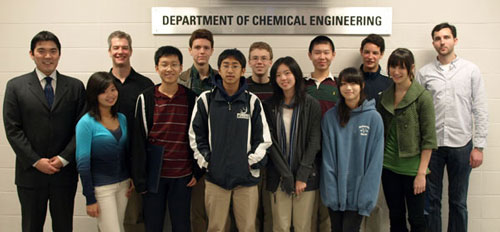From Proteopedia
(Difference between revisions)
proteopedia linkproteopedia link
|
|
| Line 15: |
Line 15: |
| | == Cofactor specificity == | | == Cofactor specificity == |
| | '''Modifying cofactor specificity, 2,5-diketo-d-gluconic acid reductase''' | | '''Modifying cofactor specificity, 2,5-diketo-d-gluconic acid reductase''' |
| - | <scene name='User:Tommie_Hata/2010_Pingry_S.M.A.R.T._Team/1a80-default/1'>TextToBeDisplayed</scene> | + | <applet load='<scene name='User:Tommie_Hata/2010_Pingry_S.M.A.R.T._Team/1a80-default/1'>TextToBeDisplayed</scene>' size='300' frame='true' align='right' caption='Insert caption here' /> |
| | | | |
| | == Substrate specificity == | | == Substrate specificity == |
Revision as of 20:01, 24 December 2009
2010 Pingry S.M.A.R.T. Team, Protein Engineering; AKR's for Biofuel Cells
The 2010
Pingry School S.M.A.R.T. Team (Students Modeling A Research Topic) is working with
Scott Banta at Columbia University to learn about enzymes being engineered for use in biofuel cells. Features being engineered into these enzymes include (1) self-assembly into hydrogels, (2) alternate cofactor use, and (3) broader substrate specificity. AdhD alcohol dehydrogenase from the thermophile
Pyrococcus furiosus is one of the enzymes being engineered with these features by the Banta Lab. AdhD is a member of the aldo-keto reductase (AKR) family of oxidoreductases. Taking advantage of its innate thermostable properties, the Banta Lab is engineering AdhD for use in biofuel cells.
The logical design and engineering of AdhD is based partially on the solved structures of other enzymes belonging to the AKR family of enzymes. Structures of mutants that bind alternate cofactors and those bound to its substrate provide insight into how to engineer AdhD and other enzymes of use in a biofuel cell. The 2010 Pingry S.M.A.R.T. Team is producing physical models of various AKR's that highlight the enzymes' structural and functional characteristics that are relevant to the Banta Lab's work.
What are S.M.A.R.T. Teams?
"
S.M.A.R.T. Teams (Students Modeling A Research Topic) are teams of high school students and their teachers who are working with research scientists to design and construct physical models of the proteins or other molecular structures that are being investigated in their laboratories. SMART Teams use state-of-the-art molecular design software and rapid prototyping technologies to produce these unique models." -from the
MSOE Center for BioMolecular Modeling Website.
The S.M.A.R.T. Team program was supported in part by Grant Number 1 R25 RR022749-01 from the National Center for Research Resources (NCRR), a component of the National Institutes of Health (NIH), awarded to the Center for BioMolecular Modeling.
AdhD and Self-assembly into hydrogels
Image:AdhD.jpg
Cofactor specificity
Modifying cofactor specificity, 2,5-diketo-d-gluconic acid reductase
| TextToBeDisplayed</scene>' size='300' frame='true' align='right' caption='Insert caption here' />
Substrate specificity
Reference
Biofuel cells
- Barton SC, Gallaway J, Atanassov P. Enzymatic biofuel cells for implantable and microscale devices. Chem Rev. 2004 Oct;104(10):4867-86. PMID:15669171
- Davis F, Higson SP. Biofuel cells--recent advances and applications. Biosens Bioelectron. 2007 Feb 15;22(7):1224-35. Epub 2006 Jun 16. PMID:16781864 doi:10.1016/j.bios.2006.04.029
Aldo-keto reductases
- Sanli G, Dudley JI, Blaber M. Structural biology of the aldo-keto reductase family of enzymes: catalysis and cofactor binding. Cell Biochem Biophys. 2003;38(1):79-101. PMID:12663943 doi:10.1385/CBB:38:1:79
AdhD and hydrogels
- Wheeldon IR, Campbell E, Banta S. A chimeric fusion protein engineered with disparate functionalities-enzymatic activity and self-assembly. J Mol Biol. 2009 Sep 11;392(1):129-42. Epub 2009 Jul 3. PMID:19577577 doi:10.1016/j.jmb.2009.06.075
Modifying cofactor specificity, 2,5-diketo-d-gluconic acid reductase
- Khurana S, Powers DB, Anderson S, Blaber M. Crystal structure of 2,5-diketo-D-gluconic acid reductase A complexed with NADPH at 2.1-A resolution. Proc Natl Acad Sci U S A. 1998 Jun 9;95(12):6768-73. PMID:9618487
- Kavanagh KL, Klimacek M, Nidetzky B, Wilson DK. Structure of xylose reductase bound to NAD+ and the basis for single and dual co-substrate specificity in family 2 aldo-keto reductases. Biochem J. 2003 Jul 15;373(Pt 2):319-26. PMID:12733986 doi:10.1042/BJ20030286
Innate dual cofactor use, Xylose reductase
- Kavanagh KL, Klimacek M, Nidetzky B, Wilson DK. The structure of apo and holo forms of xylose reductase, a dimeric aldo-keto reductase from Candida tenuis. Biochemistry. 2002 Jul 16;41(28):8785-95. PMID:12102621
- Kavanagh KL, Klimacek M, Nidetzky B, Wilson DK. Structure of xylose reductase bound to NAD+ and the basis for single and dual co-substrate specificity in family 2 aldo-keto reductases. Biochem J. 2003 Jul 15;373(Pt 2):319-26. PMID:12733986 doi:10.1042/BJ20030286
Substrate binding by an AKR, Rat liver 3 alpha-hydroxysteroid dihydrodiol dehydrogenase
- Hoog SS, Pawlowski JE, Alzari PM, Penning TM, Lewis M. Three-dimensional structure of rat liver 3 alpha-hydroxysteroid/dihydrodiol dehydrogenase: a member of the aldo-keto reductase superfamily. Proc Natl Acad Sci U S A. 1994 Mar 29;91(7):2517-21. PMID:8146147
- Bennett MJ, Schlegel BP, Jez JM, Penning TM, Lewis M. Structure of 3 alpha-hydroxysteroid/dihydrodiol dehydrogenase complexed with NADP+. Biochemistry. 1996 Aug 20;35(33):10702-11. PMID:8718859 doi:10.1021/bi9604688
- Bennett MJ, Albert RH, Jez JM, Ma H, Penning TM, Lewis M. Steroid recognition and regulation of hormone action: crystal structure of testosterone and NADP+ bound to 3 alpha-hydroxysteroid/dihydrodiol dehydrogenase. Structure. 1997 Jun 15;5(6):799-812. PMID:9261071
|



